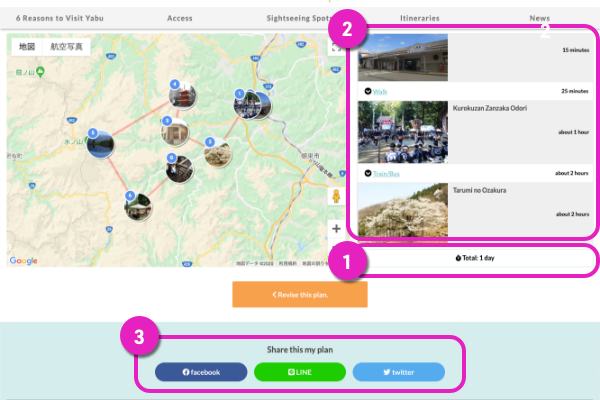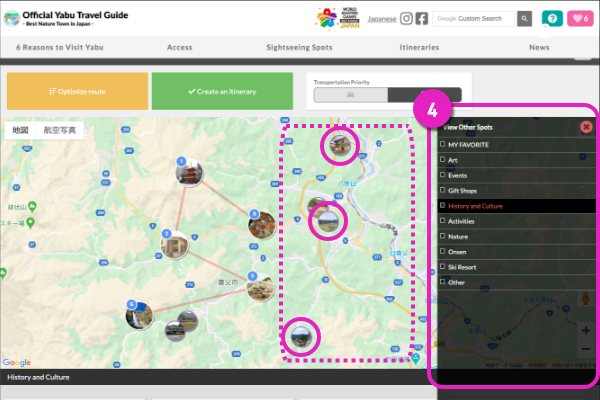How to make your own plan
Step 1
Search for places you want to visit


- Add the spots that you are interested in into ”My Plan” (your favorites)
- This can generate a route automatically by looking at the contents of ”My Plan”.
Step 2
Make a Day Plan!


- Using [My Favorite Spots] , you can put places you want to go into your plans.
- Sort in the most convenient order automatically
- Check the travel route and time by pressing the ”Direction” button (travel route by train, car or on foot will be shown).
- Create route with the ”Create an itinerary” button.
Step 3
Transfer the Plan to your smartphone and head out!

- Show the duration of the route.
- Display the entire route (by foot or by car).
- You can transfer the trip you created to your smartphone or to friends by sharing it on social media or entering your email address and sending it.
As this plan is information that was output to be shared, it will not be deleted even if the original plan is deleted.


- The plans you create will be saved under [My Plans]. Press [Create New Plan] to create a new plan.
- The plan name can be changed using the [Edit] button.
- If you press the [Pin] button, you are able to open the Category menu.
- Add the spots that you are interested in into “My Plan”


Meiba River and Meiba Bridge

Legend says when Minamoto no Yoritomo visited Awa, he found a fine black-haired horse on the land of Tayuzaki, named it “Tayuguro” and rode the horse.
| Address | 鴨川市江見太夫崎 |
|---|---|
| Tel | 04-7093-3800 |
| Opening Hours | 24h |
| Holiday | Open everyday |
| Fee | free |
Sukisaidenshi Park

The remains of the paddy field that harvested the rice offering for the suki-den building of the Daijo-sai festival (first ceremonial offering of rice by newly enthroned emperor) of Emperor Meiji. It is the symbol of the brand rice “Nagasamai” made in the Nagasa plains north of Mineokamaki.
| Address | 鴨川市北小町1859 |
|---|---|
| Tel | 04-7093-3800 |
| Opening Hours | 24h |
| Holiday | Open everyday |
| Fee | free |
Agriculture Experience

The fun of Yachimata, which is full of beautiful nature, is experiencing agriculture. Not only can you enjoy harvesting peanuts which are the specialty product of the area, you can also experience harvesting corn, sweet potato, pears, blueberries. It is an activity families can enjoy. Take a step back from your everyday life and enjoy a refreshing experience.
| Address | 千葉県八街市八街ほ35番地29 |
|---|---|
| Tel | 043-443-1405 |
Cultivation Monument of Yamata

The cultivation of the maki (pasture) was achieved through many years of hard work by many people. Many monuments related to cultivation have been erected in various parts of the city area to remember and thank the labor of the ancestors.
| Address | 八街市文違301-604 他 |
|---|---|
| Tel | 043-443-1464 |
Batōkanzeongun (including city designated "Batōkanzeongun Bodhisattva Statue")

There are more than 50 Bato Kannon enshrined in the city. Bato Kannon is worshipped as a Bodhisattva that renounces worldly desires, protects horses from illnesses and protects them. It shows how the lives of people living with horses were.
| Address | 八街市根古谷337-2(市指定) 他 |
|---|---|
| Tel | 043-443-1464 |
The Nomadotegun of Yanagisawamaki (including city designated "Yanagisawamaki Nomadote")

The nomadote (an embankment made to manage wild horses) was set up as a border and to divide the maki (pasture) so that wild horses did not cross over to the fields. Yanagisawamaki was once located in the northern part of the city, and there are still nomadote in various parts of the city.
| Address | 八街市八街ろ111-33(市指定) 他 |
|---|---|
| Tel | 043-443-1464 |
Kamagaya City Local Museum

Here you can learn the history, folklore and about the nature of the local area. On display are stoneware, earthenware, itahi (board monuments), historical documents, folkcraft articles and more, which have been discovered in the city. There are also many exhibits of materials related to maki (pastures), the cultivation of Hatsutomi and more.
| Address | 鎌ケ谷市中央1-8-31 |
|---|---|
| Tel | 047-445-1030 |
| Opening Hours | 9:00-17:00 |
| Holiday | Mondays, national holidays (closed the following day if a national holiday is Monday), December 28-January 4, temporary closure |
| Fee | free |
Kyōuninji Temple

A temple of the Nichiren sect of Buddhism famously known as the Nichiren “Komatsubara no Hōnan”. 17 years after the Persecution of Buddhists in the lifetime of Nichiren in Kōan 4 (1281), Yoshitaka no Ko and Nichiryū established the Kyōninji Temple on this land and mourned for Kyōninbō and Yoshitaka. The works of Ihachi are displayed on the three sides of the front in the Soshi-do hall which was newly constructed in Heisei 19 (2007).
| Address | 鴨川市広場1413 |
|---|---|
| Tel | 04-7092-0604 |
| Fee | free |
COLZA Horse Club

This horse-riding club boasts extensive grounds with many horse-loving members coming in on weekends. As a starting point for interacting with horses, riding classes which beginners can enjoy safely are also offered. Children older than 3 years of age are able to participate.
| Address | 千葉県八街市山田台285 |
|---|---|
| Tel | 043-445-6699 |
| Opening Hours | 9:00-17:00 |
| Holiday | Wednesday |
Koganehara no Shishikari Shiryō (Ema of Inaba Shinmeisha)

The “Shishigari no Zu”, a framed ema (votive picture of a horse) was dedicated by a villager who was mobilized in the deer hunting which occurred in Kaei 2 (1849). The scene of deer hunting is depicted, centred around the Shogun who kept the field, with samurai chasing wild boars and deer and sekoninzoku enclosing the animals with fences.
| Address | 八街市八街ほ800-3八街市郷土資料館 |
|---|---|
| Tel | 043-443-1464 |
| Opening Hours | 9:00-17:00 |
| Holiday | Mondays· New Year holidays |
| Fee | free |
Tochi Commemorative Monument

The cultivation of Hatsutomi started in Meiji 2 (1869). However, repeated crop failures led to many difficulties such as the large dispersion of people and disputes over land with cultivation companies. Despite it being difficult times, the cultivation gradually moved towards success. It was the Tochi Commemoration Meeting where the descendants remembered their ancestors and encouraged each other. This monument was erected on the grounds of Kōenji Temple in Taishō 7 (1918), the 50th anniversary of the beginning of the Hatsutomi cultivation. (City designated cultural property)
| Address | 鎌ケ谷市北初富6-1(光圓寺境内) |
|---|---|
| Tel | 047-445-1528 |
Hōsaku Inari Shrine

The Hōsaku Inari Shrine was built in Meiji 6 (1873) with hopes of harvesting abundant crops in the cultivated land of Hatsutomi. Here, there are four city designated cultural properties. The chōzubachi (washbasin) was dedicated by Yuasa, a wealthy merchant in Tokyo, who was in charge of Hatsutomi's cultivation. The bell and "Toyosakusha" was also made and dedicated the same year. The ōema, a large votive picture of a horse (exhibited at the local museum), depicts the scene of sericulture of that time.
| Address | 鎌ケ谷市初富221-1 |
|---|---|
| Tel | 047-445-1528 |
